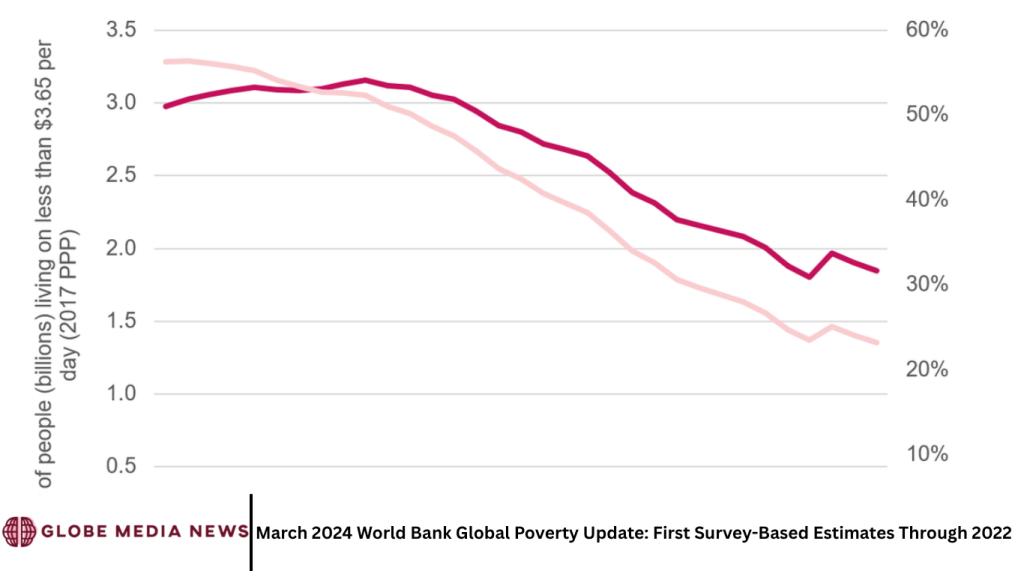In March 2024, the World Bank released a landmark update to the Poverty and Inequality Platform (PIP) — the first report to incorporate actual household survey data covering the COVID‑19 pandemic years (2020–2022).
With over 100 new surveys added, the global dataset now exceeds 2,300 country-year observations This update replaces earlier projection-based estimates, offering the most accurate view yet of how poverty has evolved during a uniquely challenging period
More Read: ADL Fact Check: Debunking Misinformation About the 2024 Presidential Election
Global Findings
1 Expansion of Data Coverage
- The March 2024 update includes 100+ new household surveys, raising total coverage to 2,300+ country observations .
- This improvement means that extreme poverty estimates for 2020–2022 are no longer model projections—they’re based on direct survey inputs during the pandemic .
2 The COVID‑19 Shock
- In 2019, 8.9% of the global population lived on less than US $2.15/day (2017 PPP).
- The pandemic caused this share to jump to 9.7% in 2020, marking the first global increase in extreme poverty in decades
- By 2022, poverty rates edged down but remained above 2019 levels. Some 23 million more people lived in extreme poverty compared to 2019
Regional Variations
1 South Asia
- Poverty in South Asia surged by 2.4 percentage points, from 10.6% to ~13% in 2020
- This region contributed significantly to the global spike.
2 Latin America & the Caribbean
- Despite COVID‑19, extreme poverty continued to decline, mainly due to Brazil’s robust fiscal response
- Latin America also saw poverty drop at the $3.65/day threshold, reflecting broader income support measures
3 East Asia & Pacific, Europe & Central Asia, Advanced Economies
- These regions held poverty levels stable or declining even in 2020—not only at the $2.15 line but also higher thresholds ($3.65 and $6.85/day)
4 Sub‑Saharan Africa & MENA
- Survey data past 2019 remains scarce, hindering reliable trend estimates
- Nevertheless, this region accounts for over half of the global extreme poor
- Projections suggest slower recovery relative to other regions.
Beyond Extreme Poverty
1 Poverty at $3.65/day (Lower-Middle-Income)
- Poverty in this threshold continued to decline or stabilize during 2020–2022, especially in Latin America and East Asia .
- Global share for $3.65/day poverty is estimated at ~26%, accounting for ~1.85 billion people
2 Poverty at $6.85/day (Upper-Middle-Income)
- Similar trends: poverty levels held steady or declined despite the pandemic.
- Global share stands near 44% (~3.5 billion people)
Methodology & Revisions
1 Updated Inputs
- Revisions included updated Consumer Price Indices, national accounts, and population data
- These inputs led to a modest revision of the 2019 global poverty rate from ~10.0% to 8.9% (~689 million poor) .
- Regionally, downward revisions occurred in Europe & Central Asia and MENA, while Sub‑Saharan Africa saw a slight upward tweak
2 Methodological Reforms
- The update aligns poverty lines across regions more consistently, refines welfare measures, and improves handling of grouped data and statistical outliers
- New tools like the Prosperity Gap and Growth Incidence Curve dashboards enhance analysis and interpretation
Understanding the “Lost Decade”
- A combination of the pandemic, conflicts, inflation, climate shocks, and debt have halted—or reversed—progress toward poverty reduction.
- Many fragile and aid-dependent countries now face a “lost decade” in poverty reduction, lacking fiscal space for recovery
- With current growth trajectories, ending extreme poverty (US$ 2.15/day) globally may take until 2030, while crossing the $6.85/day threshold could span many decades, possibly a century
A Path Forward
To reverse this troubling trend, the World Bank emphasizes:
Sustained economic growth, especially in low-income and fragile states.
Targeted fiscal interventions (e.g., cash transfers, subsidies) to support vulnerable groups — highlighted by Latin America’s success.
International aid and debt relief, especially for IDA-eligible and fragile states .
Climate resilience measures, acknowledging weather shocks disproportionately impact low-income populations .
Analytic tools (PIP dashboards), enabling policymakers to assess whether growth benefits the poor directly.
This evidence-based update underscores the importance of targeted policies and renewed global cooperation if the long-standing goal of ending extreme poverty is to stay within reach.
Frequently Asked Question
What makes this March 2024 update special?
It’s the first global estimate based on household surveys covering 2020–2022, replacing prior projections
How bad was the COVID‑19 impact on poverty?
Extreme poverty rose from 8.9% in 2019 to 9.7% in 2020, the first surge in decades—driven largely by South AsiaDid poverty drop again after 2020?Yes—by 2022, rates declined but remained slightly above 2019 levels. An estimated 23 million more people lived in extreme poverty compared to pre-pandemic .
Which regions suffered the most?
South Asia saw a 2.4 ppt increase in 2020.Latin America bucked the trend with declines, thanks to fiscal measures.Sub‑Saharan Africa lacks recent survey data but houses the majority of global extreme poor.
Are higher poverty thresholds improving?
Yes—the $3.65 and $6.85/day thresholds saw stable or declining rates during 2020–2022, reflecting resilience in middle-income regions.
How reliable are 2020‑2022 estimates?
Very reliable—based on actual survey data, not projections. However, data gaps remain in some regions (e.g., Sub-Saharan Africa) .
What does the World Bank recommend next?
- Enhance economic growth, especially in fragile contexts.
- Scale fiscal support like cash transfers.
- Provide international aid and debt relief.
- Build climate resilience.
- Use analytical tools to target interventions effectively .
Conclusion
The March 2024 update marks a critical juncture, offering a clearer and more grounded understanding of global poverty dynamics:The first household-survey-based estimates for the pandemic years.A pandemic-driven rise in extreme poverty (from 8.9% to 9.7% in 2020).Slow recovery by 2022, yet still ~23 million more poor compared to 2019.Uneven progress across regions—wealthier countries rebounded, while sub-Saharan Africa and fragile states lagged.Higher poverty rates remained stable or dropped—a hopeful sign of recovery among middle-income populations.Without systemic reforms and support, the world risks stalling or reversing earlier gains in poverty reduction.

